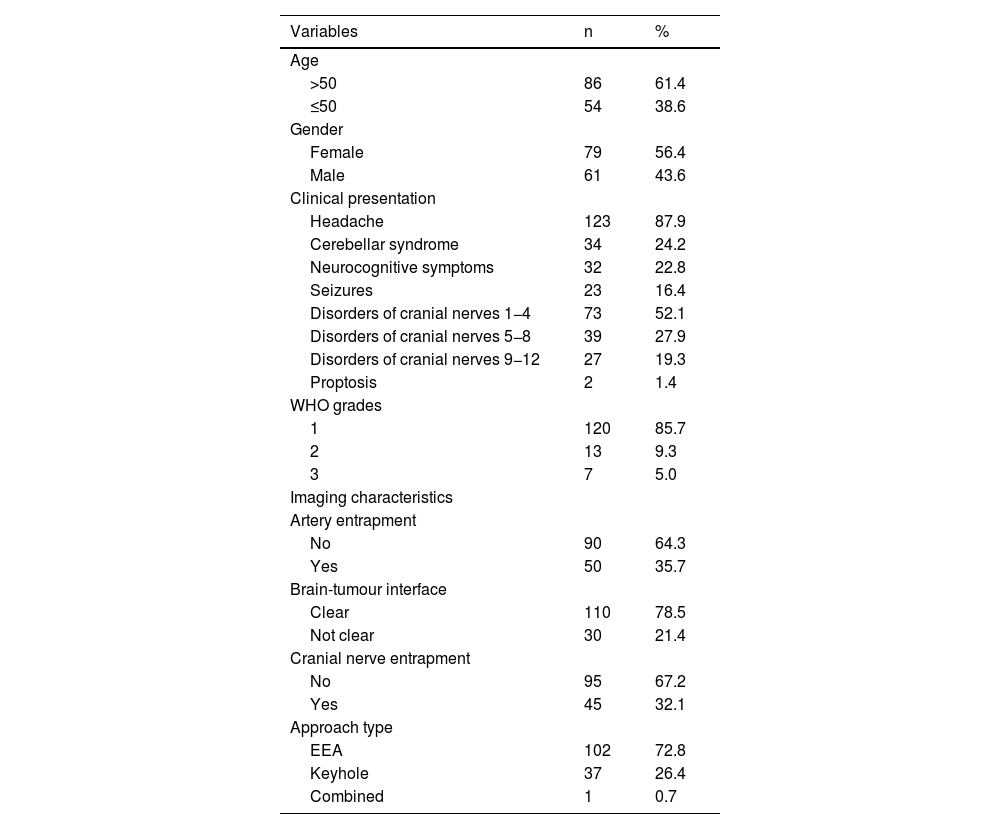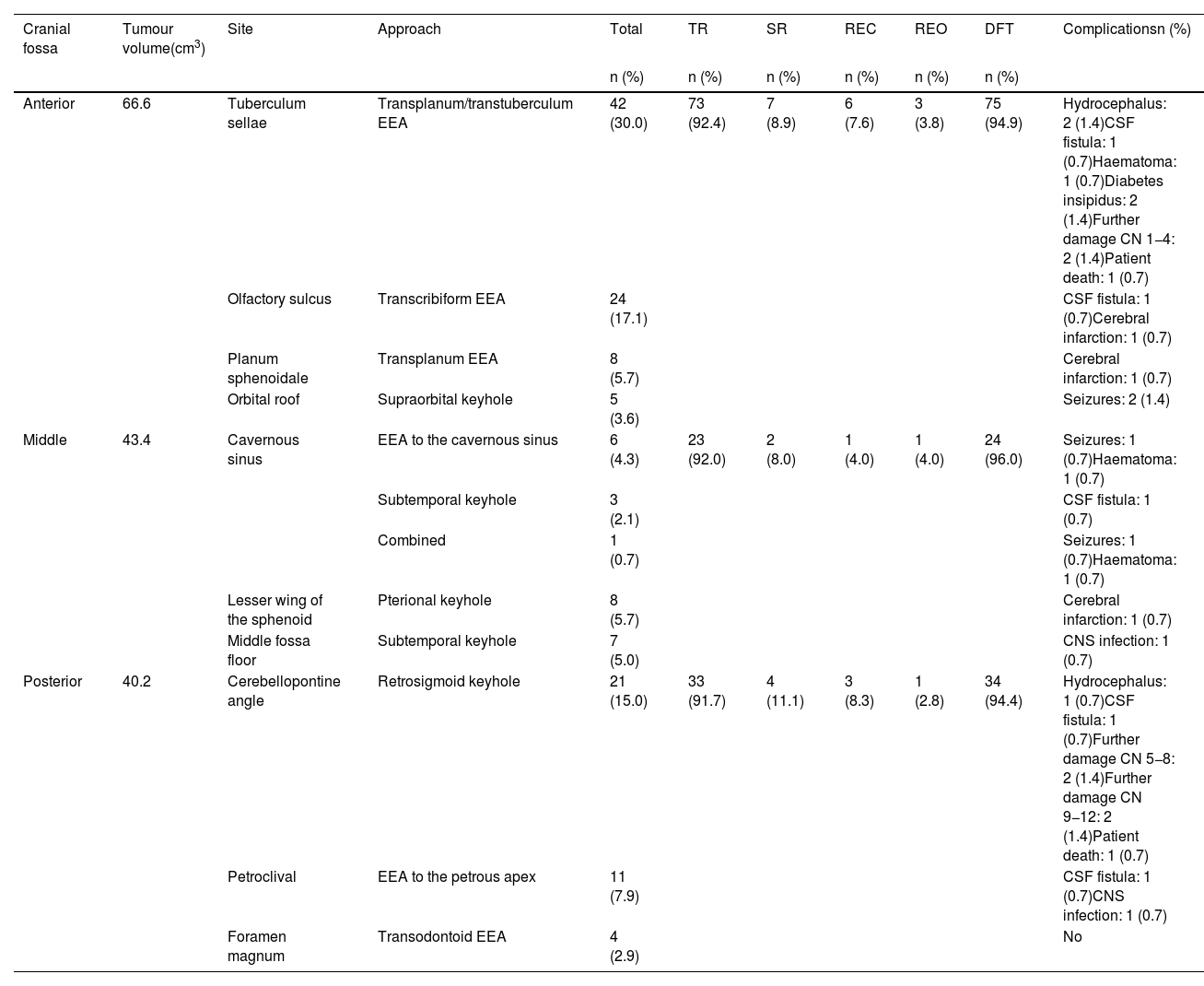Skull base meningiomas constitute a complex group of skull base tumors. The endoscopic endonasal approaches (EEA) and endoscopic Keyhole have a minimally invasive philosophy with high effectiveness, safety, and a significant decrease in postoperative morbidity in these tumors.
ObjectiveTo describe the results of the use of minimally invasive approaches to skull base meningiomas.
MethodA descriptive, retrospective study was carried out in 140 patients at the "Hermanos Ameijeiras" Hospital who underwent surgery for cranial base meningiomas using minimally invasive approaches to the cranial base. The degree of tumor resection, tumor recurrence, reinterventions, and complications were evaluated.
ResultsESA were used in 72.8% of the study, while endoscopic Keyholes were used in 26.4% and combined approaches in 0.7%. In relation to total tumor resection, 91.9% was generally achieved. Overall tumor recurrence and reinterventions were less than 8.5% and 4%, respectively. Complications in ESA were: cerebrospinal fluid (CSF) fistula (2.1%), diabetes insipidus, hydrocephalus, cerebral infarction, surgical site hematoma, worsening of cranial nerves I-IV (1.4%) respectively. While in the Keyhole type approaches: seizures (2.9%), hydrocephalus (1.4%), CSF fistula (1.4%), worsening of Nerves IX-XII (0.7%).
ConclusionsThe following study reaffirms that minimally invasive approaches for skull base meningiomas constitute advanced surgical techniques for these tumors, associated with a low rate of postoperative complications.
Los meningiomas de la base craneal constituyen un grupo complejo de tumores en la base craneal. Los abordajes endonasales endoscópicos (AEE) y Keyhole endoscópicos poseen una filosofía mínimamente invasiva con elevada efectividad, seguridad y disminución significativa en la morbilidad posoperatoria en estos tumores.
ObjetivoDescribir los resultados del empleo de los abordajes mínimamente invasivos a los meningiomas de la base craneal.
MétodoSe realizó un estudio descriptivo, retrospectivo en 140 pacientes en el Hospital “Hermanos Ameijeiras” operados por meningiomas de la base craneal mediante abordajes mínimamente invasivos a la base craneal. Se evaluó el grado de resección tumoral, recurrencia tumoral, reintervenciones y complicaciones.
ResultadosLos AEE se emplearon en el 72,8% del estudio, mientras que los Keyhole endoscópicos en el 26,4% y abordajes combinados en el 0,7%. En relación a la resección tumoral total se alcanzó de forma general un 91,9. La recurrencia tumoral y reintervenciones de manera global fue inferior al 8,5% y 4%, respectivamente. Las complicaciones en los AEE fueron: fístula de líquido cefalorraquídeo (LCR) (2,1%), diabetes insípida, hidrocefalia, infarto cerebral, hematoma del sitio quirúrgico, empeoramiento de nervios craneales I-IV (1,4%) respectivamente. Mientras que en los abordajes tipo Keyhole: convulsiones (2,9%), hidrocefalia (1,4%), fístula de LCR (1,4%), empeoramiento de Nervios IX-XII (0,7%).
ConclusionesEl siguiente estudio reafirma que los abordajes mínimamente invasivos para los meningiomas de la base craneal constituyen técnicas quirúrgicas de avanzada para estos tumores, asociada a mínima tasa de complicaciones posoperatorias.
Article

If it is the first time you have accessed you can obtain your credentials by contacting Elsevier Spain in suscripciones@elsevier.com or by calling our Customer Service at902 88 87 40 if you are calling from Spain or at +34 932 418 800 (from 9 to 18h., GMT + 1) if you are calling outside of Spain.
If you already have your login data, please click here .
If you have forgotten your password you can you can recover it by clicking here and selecting the option ¿I have forgotten my password¿.











